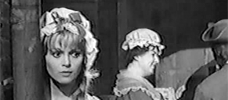Reviews
How Much Lovin’ Does a Normal Couple Need?
Russ Meyer
USA, 1967
Credits
Review by Adam Balz
Posted on 01 September 2008
Source RM Films International VHS
Categories Bosomania!: The Sex, the Violence, and the Vocabulary of Russ Meyer
Hoople’s Haven is a tumbledown cabin located along the Colorado River. Surrounded by desert and isolated from civilization, the cabin looks near inhospitable from afar—a heap of wood speckling the flat, arid landscape, something that could fall victim to even the slightest wind. As it happens, the rundown structure is a tourist trap run by ex-military man Dewey Hoople, his wife Babette, and their teenage daughter Coral. In charge of wrangling “suckers” to visit this isolated false paradise - a journey that involves driving off-road in the desert and boating through thin inlets of the Colorado - is Cracker, a salty old man with a penchant for the bottle. When we first see him, he is sitting at a bar in the heart of a nearby city, regaling the bartender with the story of his newest finds: a buxom young nurse named Sheila Ross and her insecure yet abusive husband, a doctor named Martin Ross, who is incidentally portrayed by Meyer’s fearless narrator, John Furlong. Joining them is Barney Rickert, a man who pays Cracker for a seat on his next trek back to the cabin and is, as we soon discover, one of Meyer’s most vile and vicious characters.
By the end of Common-Law Cabin, we know the truth about Rickert, that he is a city cop who’s stolen a suitcase-worth of unclaimed jewels and is hiding out at Hoople’s Haven until the heat is off. He’s a vile man driven by bestial needs, and even before Cracker’s jeep departs he’s caught the eye of Sheila Ross—and vice versa. By the film’s climax, Rickert and Sheila have seduced one another in a small pool of water hidden behind a wall of foliage. But Rickert, finding Babette in the same pool later on, takes her body by force, raping her as she struggles to go free. He then sets his sights on Coral, who professes a love of the old and inaccessible cabin while simultaneously playing coy at his attempts at seduction, agreeing to be only with him when he offers her a one hundred-dollar bill for a tour of the land. It’s when they walk out along the Colorado, and after he forces himself upon her, that Meyer introduces his final character, a strapping 21-year-old multi-millionaire named Laurence Talbot III who emerges out of nowhere in a boat and comes to her rescue.
Russ Meyer’s Common-Law Cabin is an unusual entry in the director’s oeuvre in that, while the small cast is loaded with the usual array of large-busted women, these female characters are incredibly meek, and almost all of the violence is committed by men. In fact, the closest we come to seeing one of these women commit harm against a male character is when Babette, while sitting on the shoulders of Doctor Ross, causes the middle-aged man to have a heart attack and die, sending his lifeless body into the wet sand. Laurence Talbot’s appearance marks the first time, at least to that point, that a male character actually strives to help one of the three women. Dewey Hoople is a sullen, desperate man who uses his family as cheap entertainment, referring to his wife as a servant and suppressing feelings for his budding daughter that are either drawn from fatherly anxiety or incestuous lust, and near the film’s end he give in to temptation and has sex with Sheila Ross. Martin Ross, on the other hand, is a man with a stunted confidence who tries to control his wife in an attempt to make up for his own shortcomings; he is frequently abusive, both physically and emotionally, and wants to leave the cabin almost immediately.
Initially there seem to be comparisons made between the female characters in this film and the protagonists of Russ Meyer’s Faster, Pussycat! Kill! Kill!. There is Sheila Ross, the domineering vixen who uses her body to get what she wants; Babette, the shapely and acid-tongued woman with a sensual accent; and Coral, the free-spirited young girl. Unfortunately, Sheila has no fondness for supporting her sexual appetite with violence, and when the time comes for her to exercise an aggressive side- - by firing a gun at Rickert as he rides away in Cracker’s boat - she misses him completely, uncomfortable with the power of her newfound weapon, and is in turn shot dead by Rickert. In the same vein, Babette and Coral throw only minimal punches to defend themselves against Rickert and often rely on the manpower of either Dewey or Talbot. Even Cracker, shot dead by Rickert as he returns to the cabin, is Coral and Talbot’s hinted savior—his spirit, we’re told through editing, turns the boat around after all three fall out and collides with Rickert, killing him.
Instead, Meyer seems to put more effort into highlighting the superiority of nature and rural living over city life. Rickert and the Rosses are quintessential city-dwellers contrasted against the three desert inhabitants, with Cracker acting as Charon and carrying the damned across Styx. But Hooper’s Haven, though erected in the desert, is far from a modern-day sexsploitation hell; the truth is that, even though Hooper’s “common-law cabin” is an ugly and uninteresting pinnacle of drunkenness and fornication in the American desert, it’s also home—the “haven” of its tourist-orientated title. Sheila Ross, though easily drawn into Rickert’s empty promises of a life together outside of the cabin, seems to find freedom - personal, sexual - from her husband there, just as Laurence Talbot left the significant Las Vegas - a paradise of lights and money, of crowded streets and ostentatious entertainment, of indulgences merely a step or two away - and as the film closes we see Coral and Talbot walking towards the cabin together alongside Dewey and Babette, no longer alone in their own paradise.
More Bosomania!: The Sex, the Violence, and the Vocabulary of Russ Meyer
-

The Immoral Mr. Teas / Eve and the Handyman
1959 / 1961 -

Lorna
1964 -

Fanny Hill
1964 -

Mudhoney
1965 -

Faster, Pussycat! Kill! Kill!
1965 -

Motor Psycho
1965 -

Mondo Topless
1966 -

Common-Law Cabin
1967 -

Good Morning and… Goodbye!
1967 -

Finders Keepers, Lovers Weepers!
1968 -

Vixen!
1968 -

Cherry, Harry & Raquel!
1970 -

Beyond the Valley of the Dolls
1970 -

The Seven Minutes
1971 -

Black Snake
1973 -

Supervixens!
1975 -

Up!
1976 -

Beneath the Valley of the Ultravixens
1979
We don’t do comments anymore, but you may contact us here or find us on Twitter or Facebook.



